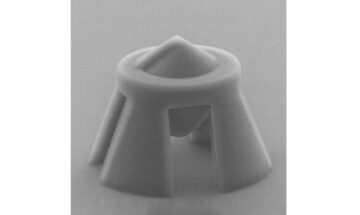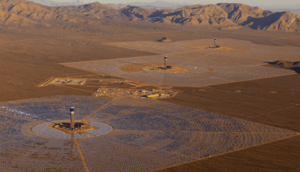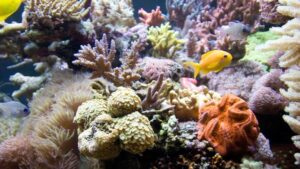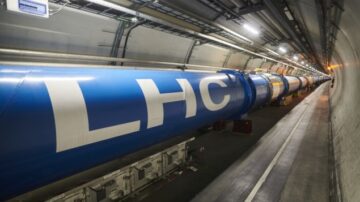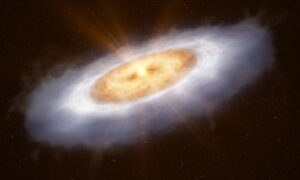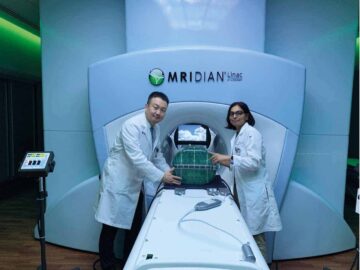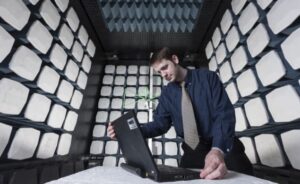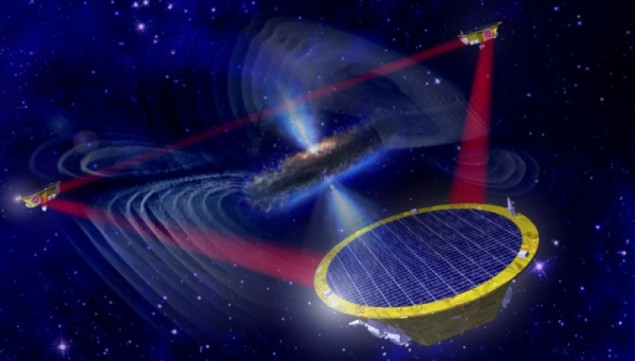
The European Space Agency (ESA) has formally approved the start of construction for its space-based gravitational-wave mission. Work on the Laser Interferometer Space Antenna (LISA) will begin in January 2025 once an industry partner has been chosen to build the craft. LISA, which is estimated to cost €1.5bn, is expected to launch in 2035 and operate for at least four years.
Gravitational waves are distortions of space–time that occur when massive bodies, such as black holes, are accelerated. They were first detected in 2016 by researchers working on the Advanced Laser Interferometer Gravitational-wave Observatory (aLIGO) located in Hanford, Washington and Livingston, Louisiana.
LISA is gravitational-wave observatory that comprises three identical satellites. They will be placed in an equilateral triangle in space, with each side of the triangle being 2.5 million kilometers – more than six times the distance between the Earth and the Moon.
The three craft will send laser beams to each other via free-floating golden cubes – each slightly smaller than a Rubik’s cube — that are placed inside the craft. The system will be able to measure the separation between the cubes to within the size of a helium atom. Such subtle changes in the distances between the measured laser beams will indicate the presence of a gravitational wave.
While ground-based instruments can pick up gravitational waves that have a frequency from a few Hz to a KHz, a space-based mission can detect gravitational-waves with frequencies between 10–4–10–1 Hz from, for example, the coalescence of supermassive black holes.
“Thanks to the huge distance travelled by the laser signals on LISA, and the superb stability of its instrumentation, we will probe gravitational waves of lower frequencies than is possible on Earth, uncovering events of a different scale, all the way back to the dawn of time,” notes astrophysicist Nora Lützgendorf, who is lead project scientist for LISA.
Cosmic visions
On 25 January ESA’s Science Programme Committee formally adopted LISA deeming that the mission concept and technology are “sufficiently advanced”.
This decision was aided by the results of the LISA Pathfinder, which was launched in 2015 on a two-year mission to demonstrate the key technologies required for LISA.

Launch of LISA Pathfinder probe heralds new era in search for gravitational waves
LISA Pathfinder consisted of two 2 kg test masses made of gold and platinum that floated freely inside the craft and were separated by 38 cm. The probe also containde a 20 × 20 cm optical bench – containing 22 mirrors and beam splitters – to measure the deviations in their movements to an accuracy of a trillionth of a metre.
In April 2016 ESA announced that LISA Pathfinder demonstrated that the LISA mission is feasible. In 2017 for example, scientists showed that the test masses on the spacecraft can be successfully isolated from electrostatic forces.
LISA is part of ESA’s Cosmic Vision long-term plan for space science. In 2013, ESA identified the “gravitational-wave universe” as the theme for its third large-class mission.
In 2017, LISA was then selected as the third large-class mission. The other two missions were the Jupiter Icy moons Explorer, which launched on 14 April 2023, and the Advanced Telescope for High-Energy Astrophysics, which is planned for launch in 2037.
- SEO Powered Content & PR Distribution. Get Amplified Today.
- PlatoData.Network Vertical Generative Ai. Empower Yourself. Access Here.
- PlatoAiStream. Web3 Intelligence. Knowledge Amplified. Access Here.
- PlatoESG. Carbon, CleanTech, Energy, Environment, Solar, Waste Management. Access Here.
- PlatoHealth. Biotech and Clinical Trials Intelligence. Access Here.
- Source: https://physicsworld.com/a/european-space-agency-gives-construction-go-ahead-for-lisa-gravitational-wave-mission/
- :has
- :is
- $UP
- 14
- 20
- 2013
- 2016
- 2017
- 2023
- 2025
- 2037
- 22
- 25
- 361
- 90
- a
- Able
- accelerated
- accuracy
- adopted
- advanced
- agency
- All
- also
- an
- and
- announced
- antenna
- April
- ARE
- artist
- AS
- At
- atom
- back
- BE
- Beam
- been
- begin
- being
- between
- Black
- black holes
- bodies
- build
- by
- CAN
- Changes
- chosen
- coalescence
- committee
- comprises
- concept
- construction
- Cost
- craft
- decision
- demonstrate
- demonstrated
- detect
- different
- distance
- each
- earth
- Era
- ESA
- estimated
- European
- European Space Agency
- events
- example
- expected
- feasible
- few
- First
- For
- Forces
- Formally
- four
- freely
- Frequency
- from
- gives
- Gold
- Golden
- gravitational
- Gravitational waves
- Have
- helium
- heralds
- Holes
- http
- HTTPS
- huge
- identical
- identified
- in
- indicate
- industry
- information
- inside
- instruments
- issue
- ITS
- January
- jpg
- Key
- laser
- launch
- launched
- lead
- least
- Livingston
- located
- long-term
- Louisiana
- lower
- made
- masses
- massive
- max-width
- measure
- measured
- million
- Mission
- missions
- Moon
- Moons
- more
- movements
- New
- Notes
- observatory
- occur
- of
- on
- once
- operate
- Other
- part
- partner
- Physics
- Physics World
- pick
- placed
- plan
- planned
- platinum
- plato
- Plato Data Intelligence
- PlatoData
- possible
- presence
- probe
- programme
- project
- required
- researchers
- Results
- ripples
- s
- satellites
- Scale
- Science
- Scientist
- scientists
- Search
- selected
- send
- showed
- side
- signals
- SIX
- Size
- small
- smaller
- Space
- space-based
- spacecraft
- Stability
- start
- Successfully
- such
- system
- Technologies
- Technology
- telescope
- test
- than
- that
- The
- their
- theme
- then
- they
- Third
- three
- thumbnail
- time
- times
- to
- true
- two
- via
- was
- washington
- Wave
- waves
- Way..
- we
- were
- when
- which
- WHO
- will
- with
- within
- Work
- working
- world
- years
- zephyrnet

